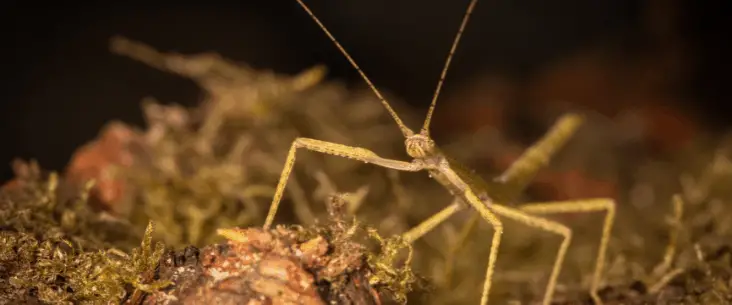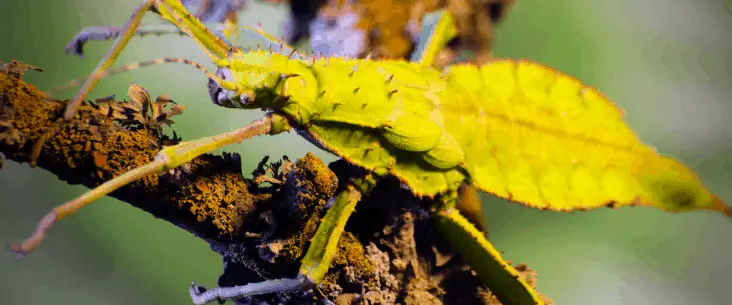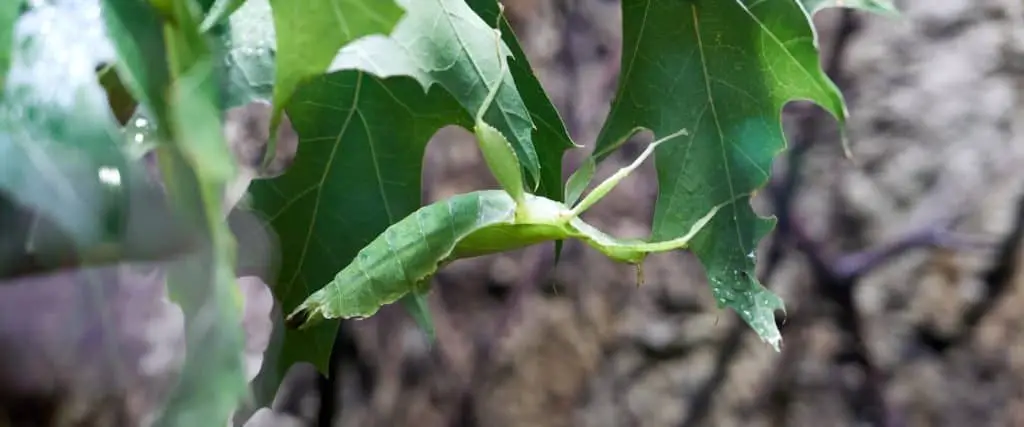One of the most stunning stick insects may probably be Achrioptera manga, also called metallic stick insect. With its bright blue-coloured body and a metallic glance, it is absolutely stunning. At least for the males as they are the bright coloured ones. Females are still beautiful but plain brown coloured. It will be obvious that these stick insects are quite popular to keep as pets. They are formerly (until 2019) known as Achrioptera fallax. All you need to know to keep these beautiful pets will be discussed in this care guide. Let’s dive in.
Metallic stick insects need an enclosure of at least 30x30x60cm, a room temperature of around 20°C and a quite humid (60-70%) environment to stay healthy. You can feed metallic stick insects with a combination of leaves from bramble, raspberry, oak or eucalyptus.
These metallic stick insects are a bit harder to keep, however when you provide the care as described in this care guide it will be no problem. We will look in detail into how to house and care for them and provide plenty of care tips and tricks to let your (future) metallic stick insect thrive.
We partner with companies that offer products that we think are great for you to use, and that can help you achieve your goals. If you purchase through our partner links, we get paid for the referral at no additional cost to you! Please read our disclaimer for more info.
About metallic stick insects (Achrioptera manga)
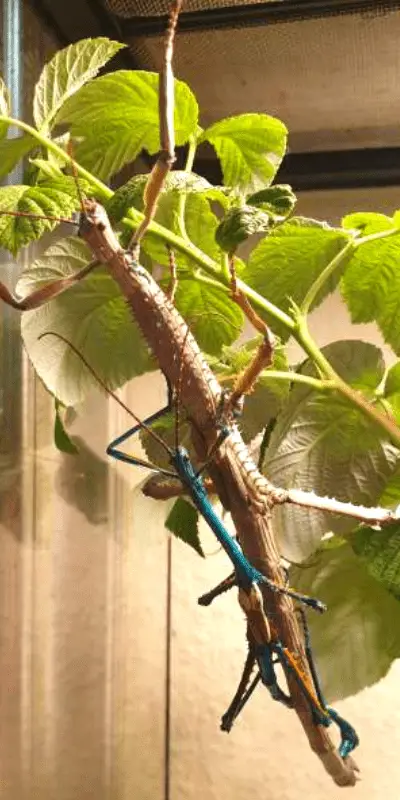
Appearance and camouflage
As mentioned in the introduction, the metallic stick insect was mostly known by the name Achrioptera fallax but is reidentified in 2019 as Achrioptera manga. That makes no difference in the beautiful colours this species has. It is well-known for its blue colour with its metallic glance. However, it is only the males that have these bright colours. Females, although stunning in size (some specimens known to be up to 26cm), have much more plain brown colours. The males have also orange spikes that are most visible on the middle hand hind legs.
This stick insect has the typical build on a long tube-like body with six long legs. Also, its head, which can be quite large with females, have strong mandibles to consume plant leaves — although they are unable to bite or inflict damage to humans. The bright colours look like warning signals but these creatures are harmless. They are even rather clumsy when horizontal.
Both males and females have underdeveloped wings — although the males are more brightly coloured — and they are unable to fly. They use the wings as signalling. Males can also make loud hizzing sounds when startled to scare off any predator.
It is quite unusual to find stick insects with such bright colours and it is counterintuitive for camouflage, although when sitting still and with the legs along their body, they are still sometimes difficult to find in dense bushes. However, these animals are from Madagascar and you see some more strange evolution on that island when it comes to colours and shapes of animals.
Behaviour, temperament and handling
As said before, these animals can be quite clumsy and when startled may let them fall of the branch. Males tend to make a very loud hizzing noise. Besides that, these species are pretty calm and are beautiful to watch.
These species can be handled, but care must be taken because stick insects are very fragile creatures. Never try to pick up a stick insect from a branch. They have little hooks on the tip of their feet which work like grappling hooks. Together with fragile body segments, a leg is quickly detached when picked up.
Better is to let them walk onto your hand by nudging carefully on their back. When on your hand, don’t keep them too high above a surface. They are clumsy and when they fall off (or let themselves fall off your hand) can inflict damage to the animal.
When not needed, it is better to leave these animals in the enclosure. When you need to move the animals from one enclosure to another, let them walk on a twig that you can place in the other location.
Maybe you like this article: 15 surprisingly interesting facts about stick insects

Housing setup
In this section, we will take a closer look at how to house metallic stick insects. Generally, stick insects don’t have high needs for housing and the enclosure setup is quite easy, but they still need a proper enclosure to keep them happy and healthy.
Tank type and size
You can use different types of enclosures to house metallic stick insects. One of the most common options is to buy a terrarium. There are several terrariums that come in the right size and have proper access and ventilation. Brands like Exo Terra and REPTI ZOO make perfect terrariums that can be used to house metallic stick insects. One low-priced terrarium that I can recommend can be found here on Amazon. This model has the right size and provides enough ventilation without stick insects escaping the enclosure.
However, terrariums can be quite expensive and a cheaper option is to buy a plastic storage box that you can modify into a stick insect enclosure. There are plenty of storage boxes available, you just need to find the right size. However, these boxes are often closed off completely without proper ventilation. You should create enough ventilation by drilling many small holes or cutting out holes and covering them with metal wire mesh. Make sure there is no room for your stick insects to escape (and also mind the little ones when they just hatched).
Proper access to your enclosure is important. Make sure you can access the enclosure via the top or the front of the enclosure and that there is enough room to take out the food, for example. More on that later. Terrariums have often a top panel that can be removed or large doors that can be opened at the front.
We mentioned several times that the enclosure needs the right size, but what is the right size for metallic stick insects? Especially the height of the enclosure is important. Stick insects need to moult several times and do that by hanging at the top of the enclosure and letting themselves glide out of their old skin. If there is not enough room, they can’t moult properly and old skin stays attached or they even get stuck in their old skin.
A golden rule is that the height is three times the size of the adult body size. So in this case, the females will be around 22cm (8.6″), so the enclosure should at least have a size of 60cm (24″) high. The width is about 1.5 times to 2 times the adult body size, around 30cm to 45cm (12″ to 18″) so that they have enough room to crawl around.
Tank substrate and decor
Although many insects need some sort of substrate, some stick insects make the exception. Because metallic stick insects drop the eggs on the floor (while others dig them into the substrate) they don’t necessarily need a substrate.
However, you can still add a substrate for esthetic reasons. Good options for a substrate are coconut fibre, topsoil or vermiculite. My preference is for coconut fibre. It is a clean product, looks natural and has a good ability to absorb water. Interested in coconut fibre? Coconut fibre is simply and cheaply available on Amazon.
Now the water absorption capacity makes substrate interesting for another reason. These stick insects like a humid environment and adding a substrate makes it easier to keep the environment humid.
Another option for a “substrate” is using paper or cloth towels on the bottom of the enclosure. It still absorbs and slowly releases water to keep the environment humid, but it is easier to maintain. Another benefit of egg-dropping stick insects is that you can effortlessly collect the eggs and distinguish them from stick insect frass (faeces).
Stick insects need to be able to climb around in the enclosure. So, provide a couple of dead twigs and branches so they can climb and hang. They will also use it to moult or to climb back up again when they have fallen down (yes that happens from time to time). With some branches, your enclosure also looks more natural and nice to look at. To make access easy to refresh the food or clean the enclosure, place the branches along the sides and the back of the enclosure so you maintain enough room to work.
Tank location
Now you are ready to set up your stick insect tank. One important note that I want to make is the location of the enclosure. I’m sure you have already a place in mind where you want to place it. However, there are several don’ts when it comes to where you keep stick insects.
First, these stick insects are not suitable to keep outside (even on warmer summer days) because of different temperature fluctuations and humidity levels. Besides, in nature, the animals can search for their own climate sweet spot, but within a captive environment, they can’t escape too much heat or too high humidity.
However, the same sort of applies inside as well. What I mean is that you must not place a stick insect tank in direct sunlight. It causes a rise in temperature that is lethal for stick insects and they can’t escape from that heat.
When finding a suitable place for your stick insect enclosure avoid locations that have a lot of vibrations like close to music (e.g. radio, television) and for example running kids. Also, when having other pets such as a dog or a cat, for example, be careful that they can’t knock over the enclosure. Finding a steady and quiet location out of direct sunlight will be perfect.
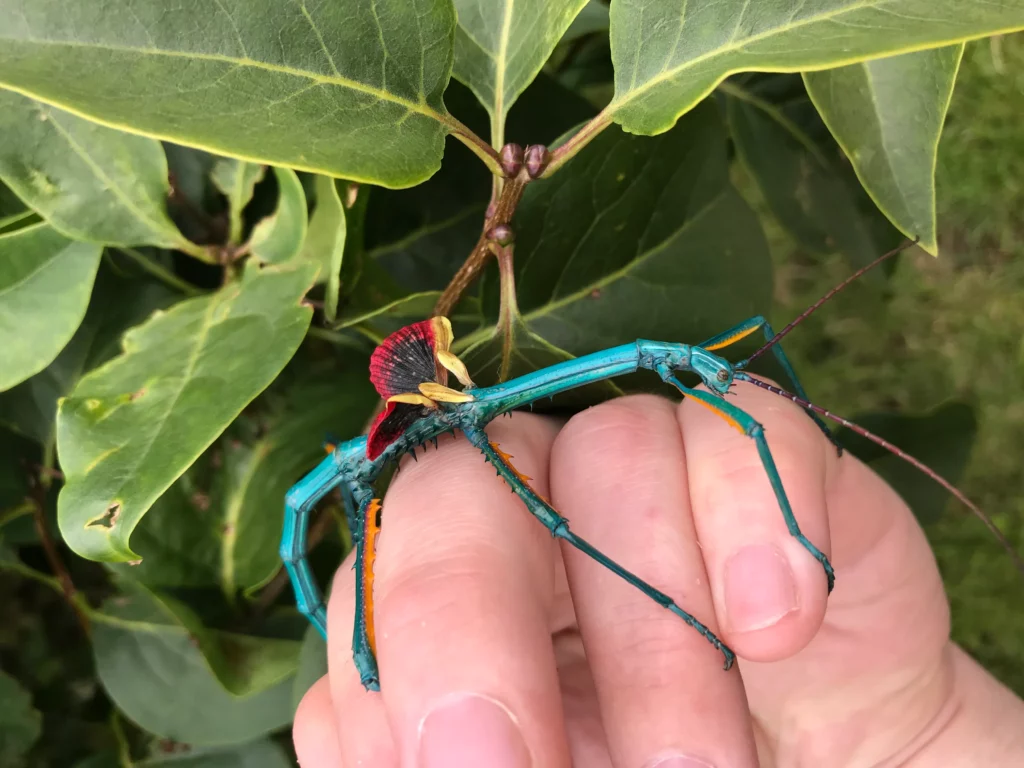
Shopping list for metallic stick insects
Here I selected a couple of items that I recommend using for keeping stick insects. I have selected different tanks (and one netting cage) depending on what you prefer. However, throughout the article, I link to other products that I recommend and personally use as well.
Recommended read: How Much Do Stick Insects Cost: Initial & Yearly Cost Breakdown
Climate conditions
Now you have the information to set up the enclosure, let’s talk about the climate conditions these stick insects need. Stick insects are dependent on their environment to thrive and can’t maintain their own body heat. So first let’s look at the temperature.
Temperature and heating
These stick insects well at room temperature — meaning you should keep them at a stable temperature of around 20°C (68°F). Generally, no additional heating is necessary to keep metallic stick insects. However, when you live in an area where there is a lot of temperature fluctuation it could be a good practice to use a heat source.
As a heat source, you have two common options: a heat lamp and a heating pad. Although there are specific heat lamps available, a normal light bulb would be sufficient to heat the enclosure. A heating pad is also an option. It is best to put it on the backside of the enclosure instead of under the enclosure. When placed under the enclosure the heat can’t escape well enough and eggs that are dropped on the enclosure floor can overheat and dry out.
Because room temperature is already optimal and you only use it when the temperature drops frequently it is a good practice to use some sort of control for the heating source. In the case of the light, you can use a timer, whereas a heating pad is better to be used in combination with a thermostat controller. But in many cases, a heating source is not necessary.
Humidity and spraying
A humid environment is essential for keeping your stick insects healthy and happy. One reason a humid environment is important is during moulting. When the stick insect is ready to moult and the environment is too dry, the animal can get stuck in its own skin. Higher humidity helps to have them better moults.
Also, the animals and eggs can dry out when the environment is too dry. Metallic stick insects need a humidity of around 60% to 70%, which means it must be quite humid. You can mist spray the enclosure mildly every day or every other day. Be careful not to make it too wet though. If you spray too much the moisture accumulates in the enclosure and warmer temperatures in combination with frass will increase mould growth.
Spraying water not only increases the humidity but also provides water for drinking. Your stick insects won’t drink water from a drinking bowl — it can even cause (young) animals to drown. Instead, they drink the water drops on the window, branches and food plants.
Light and light cycle
Although not scientifically proven, many suggest that stick insects do benefit from a normal day and night cycle of 12 hours light and 12 hours dark. At least it cannot harm the animals. Generally, the room where you place the enclosure has a normal day/night cycle. However, you can also mimic light by placing a regular light above the enclosure. Be careful that it is not heating the enclosure too much (see also the section about temperature and heating). If you do not have to heat the enclosure, you can use a LED light instead which produces much less heat.
Not only adult stick insects can benefit from a normal light cycle, but it is also believed that stick insect eggs benefit from a regular light cycle for their development. So when raising stick insect eggs separately, also provide some daily light for that enclosure as well.
Food & feeding
Metallic stick insects are strictly herbivores and only eat plant leaves. Moreover, they only eat the leaves of particular plants. These stick insects accept the leaves of the following plants:
- Bramble
- Raspberry
- Oak
- Eucalyptus
You can place the stem with several leaves of these plants in a vase. Use a vase with a small opening so stick insects can’t crawl or fall in and drown. You can also use a plastic pot and drill some holes in the lid. Fill the vase or pot with water to keep the leaves fresh longer. Before placing the leaves into the enclosure, mist sprays them with water to keep them fresh as well and provide drinking water for your animals.
Be sure to collect the leaves of these plants in places where there is no contamination like pesticides, chemicals or too much car exhaust dust. Use only clean and fresh plant leaves. I’ve written a complete and in-depth guide on what and how to feed stick insects that I recommend you to read.
Refresh the food when the leaves are withering and turning brown. When you keep them watered and spray them every (other) day, they may last for one or two weeks before you need to change them.
Recommended read: What to feed stick insects: A helpful guide
Cleaning routine
One of the reasons why stick insects are such a popular pet is because there is not much cleaning involved. Stick insects don’t make much mess and cleaning is rather easy. Do a daily check for dead animals and remove them when they have passed away. When you see some mould remove that as soon as possible so it will not overgrow your enclosure. The rest of the cleaning can be done once a week.
A common cleaning routine exists of removing dead leaves and removing most frass out of the enclosure. Any other dirt spots (in the substrate for example) or mould should be cleaned as well. When you refresh the leaves (once a week or so) is the best moment to do the cleaning.
Once in a while, you can do some extensive cleaning by wiping the glass/plastic walls with some water and citron or lime juice to remove (calcium) stains from spraying water. Don’t use anything else than water. Any chemical cleaning soap (even the biological ones) is unhealthy for your stick insects.
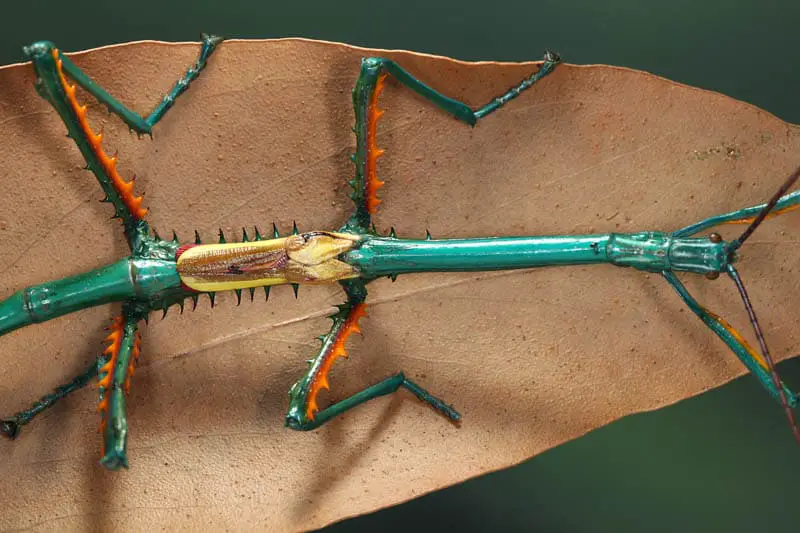
Breeding metallic stick insects
Breeding metallic stick insects is quite easy. When you have a male and female you probably soon have eggs as well. These species only reproduce sexually — and not parthenogenetic as some other species do.
As mentioned earlier these stick insects drop the eggs on the floor. These stick insects don’t have any parental care and after 4 to 5 months the eggs — when kept in the same condition as the adults — will hatch and tiny stick insects will emerge.
Now these tiny young stick insects, also called nymphs, are very fragile. It is best to keep and raise them separately from the adults. The easiest way is to collect the eggs and keep them in a nursery enclosure and when hatched raise them there. When they have had two moults (which is called L3 stadium) you can add them to the adult enclosure.
These nymphs can be kept in the same conditions as the adults and can be fed the same food. Bramble is often best accepted. To make it easier for the young nymphs to eat you can trim the edges of the leaves. It also stimulates them to start eating.
Be careful with spraying water and never spray directly on the young stick insects. Small ones can get stuck in the water or even drown in a big droplet of water. When spraying, try to make the mist really fine or spray fresh leaves and place them in the enclosure.
If you are interested in more in-depth information about breeding metallic stick insects or any other species for that matter, I can encourage you to read the guide about breeding stick insects.
Much more to learn!
There is much more to learn about stick insects. For example, do stick insects need a substrate? You can find more articles about stick insects with plenty of practical tips to better understand and enjoy the keeping of stick insects as a pet.
Featured image courtesy Drägüs (source)
Share this page!

